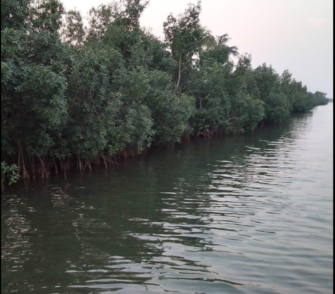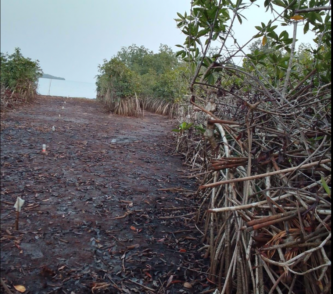Building local climate resilience through mangrove restoration in Western Liberia
Metrics
Community
Grand Cape Mount CountyCommunity Size
129,817University
University of LiberiaStatus
CompletedCase Type
Project StoriesFocus Areas
Climate Change, environment, SustainabilityRegion
AfricaUniversity Department Code
Environment and Climate ChangeSustainable Development Goals
11 Sustainable Cities and Communities, 13 Climate ActionGrand Cape Mount County in Western Liberia is home to Lake Piso. This large lake accommodates a sizable mangrove forest that is essential to the lake’s ecosystem and village areas as it provide protection against erosion and absorbs harmful storm surges. One of the biggest advantages of the mangrove forest is its ability to sequester large amounts of carbon from the atmosphere and store it underwater in the soil for the next millennia. This capability is essential in the fight against climate change and will become increasingly vital in the years to come.

Regrettably, the mangrove forests surrounding Lake Piso have witnessed a concerning decline in recent years. Pollution is a significant peril to Lake Piso caused by industrial operations, agricultural runoff, and insufficient refuse management issues. Water quality is also adversely affected by various pollutants creating a detrimental effect on aquatic life and renders water resources unfit for human consumption and recreational purposes. The lake also suffers from unsustainable fishing practices upsetting the delicate hierarchy of the aquatic ecosystem and jeopardizing the food security of the surrounding communities.

Climate change will also continue to exacerbate the environmental pressures on the mangrove forest as altered rainfall patterns and rising temperatures create additional obstacles for mangrove preservation. The potential extinction of mangroves presents a substantial hazard to the local biodiversity affecting the economic prosperity of the neighboring communities that rely on the timber, fish, and crustaceans supplied by the ecosystem.
One of the most direct threats to the mangroves comes from a process known as fish smoking. This happens when fishermen catch fish from the lake and sell the fish in local fish markets. To preserve the freshness of the catch for market viability, the fishermen suspend the fish from logs or trees, lighting a fire underneath them. The ensuing smoke from the fire envelops the fish, thereby prolonging their freshness and enabling profitable sales at fish markets. This process, known as fish smoking, predominantly relies on the use of mangrove wood to fuel the fires, intensifying the demand for such wood and threatening the conservation of the mangrove forest.
Because of these harmful practices, there have been significant efforts to institute conservation intervention programs in areas near Lake Piso to encourage the preservation of the mangroves. The government has instituted mangrove conservation training programs that educate citizens on the importance of the mangroves and the negative impacts associated with the degradation of the forest. After the implementation of these programs, the government has not analyzed their effectiveness or looked at best practices to improve the program.
This prompted Professor James McClain and a team of ten undergraduate and graduate students affiliated with the University of Liberia’s Department of Environment and Climate Change to evaluate the successfulness of these conservation programs. Taking advantage of the EPIC model, Professor McClain and his students partnered with the local government in the Commonwealth area of Lake Piso and devised a multi-objective study to understand conservation support on the management and sustainable use of mangrove vegetation. Through this project, the team completed a desk review of current conservation training strategies, a map of important organizational stakeholders, a GIS analysis of management intervention zones, and identified mangrove restoration areas.
To understand the development of outside conservation programs, students completed a literature review of key studies analyzing the conservation training methodology of eight different organizations. This review specifically looked at the diverse methods used to preserve mangrove trees. Upon completion of this review, Professor McClain’s team identified four key organizations including NGO’s, CSO’s, and government agencies that took part in mangrove conservation training in the past decade. These organizations included the Society for Conservation of Nature of Liberia (SCNL), Conservation International, United Nations Developmental Program (UNDP), and the Green Globe Consultancy. Once the organizations were identified, students conducted interviews with each organization to better understand their conservation training methods.
The UNDP was identified as having the most successful and innovative conservation training method. The organization trained individuals on the use of eco stoves, energy-efficient devices designed to generate heat for cooking. These stoves can be engineered to optimize heat retention, ensuring efficient utilization for cooking purposes and minimizing heat loss to the surroundings. This not only reduces emissions but also enhances burning efficiency generating more heat with less fuel. Instead of a kilogram of mangrove wood to smoke fish, many fishermen can achieve the same results with just half a kilogram. Consequently, this diminishes the need for weekly mangrove wood purchases and decreases the incentive to engage in mangrove wood cutting. While these stoves replicate the desired outcome of fish smoking, they entail significantly fewer ecological consequences.
With the desk review and the stakeholder analysis complete, students began thinking about how they could apply these best practices to the Lake Piso community. To gain a better grasp on local training effectiveness, the students developed and completed a community face-to-face survey in the Lake Piso, Commonwealth District. At a town hall meeting with the clan and town chiefs from every Commonwealth district, residents of Robersports learned more about mangrove preservation and completed the student led survey. The purpose of the survey was to ascertain the utilization of mangrove wood before and after conservation training.
The students surveyed individuals in three additional communities in the Lake Piso Commonwealth District. Overall, the students were able to survey 176 people from Tozor, Latia, and Sembehum and asked them about their interactions with mangroves before the training took place. The students found that pre-conservation training, individuals cut mangroves often or sometimes about 80% of the time. Of those who cut the mangroves, about 50% used them to smoke fish. Additionally, many citizens who did not cut mangroves still participated in buying mangrove wood to dry fish. Post-conservation training, the students found that there has been a slight decline in mangrove cutting suggesting that conservation training is useful for mangrove conservation.
While the trainings seemingly reduce the cutting of the mangrove, students noted that the rationale for logging mangroves remains unchanged because people still use mangrove wood for fish curing, cooking, and selling. For these reasons, the students recommend that it is important to fund energy-efficient solutions such as the eco stoves described above alongside the conservation training programs. The survey showed the act of dehydrating fish is often a citizen’s main use of mangrove wood. By eliminating this need, the cutting of the mangrove trees will be significantly reduced. It is important to note that while this community survey brought forward data about the mangrove conservation training programs, there was a lack of large community participation. This small sample group may not be a large enough representation of the whole community.
Along with the stakeholder mapping and community survey, the students also used Geographic Information System (GIS) technology to understand the level of mangrove degradation in Lake Piso. The students analyzed mangrove datasets that mapped the mangrove populations near Lake Piso from 1975, 2000, and 2013 and found that the mangrove forest depreciated a total of 0.7%. This may seem like a very small depreciation rate, but as climate change continues to accelerate mangrove deprecation rate will continue to grow which can create large problems for the surrounding ecosystem. The GIS analysis also found three specific areas that were heavily degraded in Lake Piso that could be potential restoration sites.
As degradation becomes increasingly more common, it becomes critical to implement and enforce stringent policies and regulations to protect mangrove habitats from deforestation, pollution, and unsustainable exploitation. This entails the implementation of sustainable management practices, the designation of protected areas, and the encouragement of community-driven conservation initiatives and practices. The success of these policies relies on the enhanced education and awareness of policymakers, stakeholders, and local communities concerning the importance of sustainable conservation methodologies and the intrinsic worth of mangroves. Active participation in mangrove conservation and restoration initiatives can foster a sense of ownership and responsibility among regional communities.
Overall, the commitment to climate initiatives exhibited by Professor McClain and his students at the University of Liberia instills hope for the development of a sustainable solution to mangrove preservation. Because of the EPIC model, Professor McClain and his team of students have been able to work alongside local government organizations, NGOs, and conservation organizations to enhance the local community’s knowledge of sustainable alternatives to prevent mangrove degradation. With the continued interventions of Professor McClain and the EPIC program, there is a strong belief that communities will start to see a resurgence of the mangrove.

